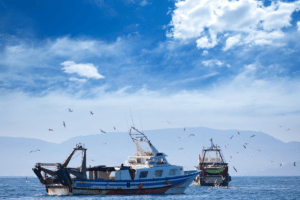The fishing industry is among the most lucrative professions in the world, but it is also among the most dangerous. According to a 2012 U.S. Bureau of Labor Statistics report cited by Forbes, fishing professionals work in the second deadliest industry. Maritime workers employed in seiners and other fishing vessels die at a rate of 117 per 100,000 workers. In 2012, 32 fishing industry employees died in accidents, including several aboard seiners. Although some accidents are a result of worker carelessness, many of these accidents were caused by issues of unseaworthiness or negligence on the part of masters, owners, or other crewmembers.

Seiner Boats and Associated Risks
Seine fishing, also known as seine-hauling, is a method of commercial fishing named after a type of net called a seine. Seine nets, or dragnets, hang vertically in the water. Their bottom ends are held down by a series of weights, and floats buoy their top edges on the surface of the water. The most common types of seiner nets deployed on vessels known as seiners are purse seiners and Danish seiners.
Seiner boats make up a large portion of American fishing fleets, especially those that work off the Pacific coasts and the Bering Sea. The largest seine fleet is based in Washington State and Alaska. The fleet is composed of vessels with lengths that range from 30 to 115 meters and can carry up to 4,000 tons of tuna or skipjack. However, the average deep-ocean purse seiners measure between 70 to 80 meters and can hold 1,000-1,500 tons of frozen catch. They usually go on fishing trips that last several months before returning home.
Although crew members on commercial fishing boats can potentially earn $10,000 a month if they have good hauls during the working season, there are many dangers that come with the job. Crewmen have to work in cramped vessels on waters that are often rough, icy, and affected by bad weather. Not only are the boats cramped and uncomfortable, but the working days are often long, some lasting up to 21 consecutive hours. In addition, the equipment on seiners of either the purse- or Danish-seine type nets is dangerous.
Typical Injuries Caused by Seiner Boat Accidents
Working on a seiner boat out at sea can cause a wide range of accidents which result in serious injuries or even deaths. The most common are cuts, bruises, and sprains and strains caused by handling equipment, overusing electrical tape, or getting hands caught in hooks and seine nets. Some of these injuries can be avoided by taking precautions such as wearing gloves and taking proper care while handling gaffing hooks, scaling knives and other sharp tools.
Other injuries, however, are caused by working on decks cluttered with nets and heavy equipment, unseaworthy vessels, poorly-maintained equipment, inexperienced deckhands, or bad managerial decisions that keep seiner crews working too many hours a day.
Injuries suffered by seiner crew members include:
- Spinal cord injuries from falls
- Head injuries
- Loss of limbs
- Lacerations and scarring
- Broken bones
- Crushed limbs
The worst situations faced by seine-fishing crews involve sinkings, capsizes and collisions at sea. In 1998, the National Transportation Safety Board (NTSB) reported the loss of the fishing vessel Evanick, which capsized near Kodiak, Alaska. The Evanick suffered $250,000 in property damage and four crewmembers died. On April 2, 2001, a seine-fishing vessel called the Arctic Rose sank in the Bering Sea without issuing a distress call. All of the 15 crewmembers died. In August of 2012, six seine fishing vessels sank off the coast of India in a two-week period. None of the crews died, but poor maintenance, lack of state-of-the-art navigation equipment, and boats in poor states of repair were blamed for the incidents.
Compensation for Injured Seiner Boat Crews
Seamen who are injured aboard seine-net fishing boats have the legal right for compensation. General maritime law and the Jones Act give injured fishing industry employees who work at sea the right to file claims against captains, ship owners, or fellow crew members if the injuries were caused by negligence or if the vessel was unseaworthy.